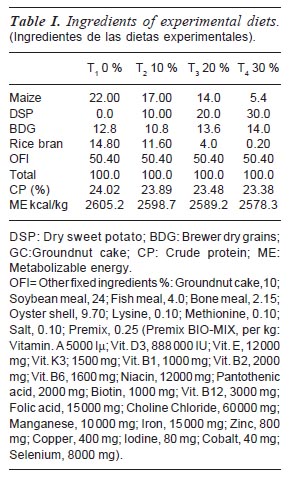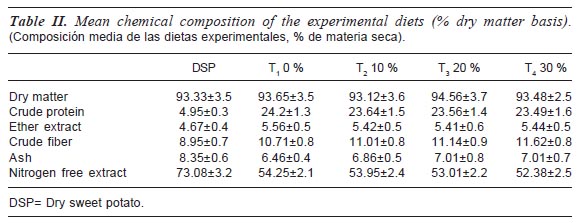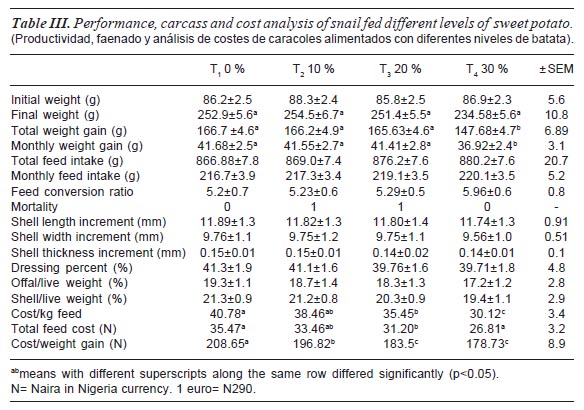Meu SciELO
Serviços Personalizados
Journal
Artigo
Indicadores
-
 Citado por SciELO
Citado por SciELO -
 Acessos
Acessos
Links relacionados
-
 Citado por Google
Citado por Google -
 Similares em
SciELO
Similares em
SciELO -
 Similares em Google
Similares em Google
Compartilhar
Archivos de Zootecnia
versão On-line ISSN 1885-4494versão impressa ISSN 0004-0592
Arch. zootec. vol.62 no.238 Córdoba Jun. 2013
https://dx.doi.org/10.4321/S0004-05922013000200015
SHORT NOTE
Utilization of dry unpeeled sweet potato (Ipomea batatas) in the diet of snails
Efecto de la utilización de batata (Ipomea batatas) sin pelar en la dieta de caracoles
Omole, A.J.1*; Obi, O.O.1; Ajasin, F.O.2; Okpeze, C.N.2 and Olasehinde, T.1
1Obafemi Awolowo University. Institute of Agricultural Research and Training Moor Plantation. Ibadan, Nigeria. *omoleboye@yahoo.com
2Federal College of Animal Health and Production Technology. Ibadan, Nigeria.
SUMMARY
This study was designed to determine the effect of inclusion of varying levels of dry unpeeled dry sweet potato on growth characteristics and cost analysis of growing snails (Archachatina marginata). One hundred and twenty snails of mean weight of 86.6 g were randomly selected and allotted to 4 dietary treatments. Each treatment was replicated thrice with ten snails per replicate in a completely randomized design. Four diets were formulated to contain 0 % (T1), 10 %(T2), 20 % (T3), 30 % (T4) dry unpeeled sweet potato (DSP) of the entire diet. The parameters taken were weight gain, feed intake on weekly and daily basis respectively. Feed conversion ratio, total feed cost, and cost per weight gain were calculated. Significant differences were not observed in the mean monthly feed intake of snails fed diet containing varied levels of DSP (p>0.05). There were no significant differences in the mean monthly weight gain of snails fed diet containing 20 % DSP and the control diet (p>0.05). The feed conversion ratios were not significantly different from one another (p>0.05). The dietary treatments had no significant effect on the mean monthly shell length, width and thickness increment and dressing percentage of the snails (p>0.05). The lowest cost/weight gain was recorded in the diet containing 30 % DSP. Snail could tolerate up to 30 % dry unpeeled sweet potato in the diet without any adverse effect but at a reduced cost.
Key words: Cost/weight gain. Dressing percentage. Dry unpeeled sweet potato. Feed utilization snails.
RESUMEN
Este estudio se diseñó para determinar el efecto de diferentes niveles de batata seca sin pelar sobre las características de crecimiento y costes de caracoles (Archachatina marginata) en crecimiento. Ciento veinte caracoles de 86,6 g de peso medio fueron aleatoriamente seleccionados y asignados a 4 dietas diferentes. En cada tratamiento se realizaron 3 repeticiones de 10 individuos cada una, en un diseño completamente al azar. Se formularon 4 dietas que contenían 0 % (T1), 10 % (T2), 20 % (T3) y 30 % (T4) de batata seca sin pelar (DSP). Se analizaron la ganancia de peso semanal y la ingestión diaria de alimento. Se calcularon la conversión alimenticia, costes total de alimentación y ganancia de peso. No se observaron diferencias en la ingestión mensual de alimentos ni en el índice de conversión en los diferentes tratamientos. No hubo diferencias en la ganancia mensual de peso en los caracoles que consumían 20 % de DSP, ni en la dieta control. No hubo diferencias mensuales significativas sobre el incremento de la longitud, anchura y espesor de la cáscara ni sobre el faenado. El menor coste/ganancia de peso se consiguió con 30 % de DSP. Los caracoles pueden tolerar hasta un 30 % de DSP sin efectos adversos y a coste reducido.
Palabras clave: Batata desecada. Caracoles. Ganancia de peso. Relación coste/ganancia de peso. Rendimiento faenado.
Introduction
Snail production has the potentials for very huge returns on investment with extreme low level of inputs and it requires little technical experience (Avagnina, 1982; Awah, 1992; Amubode and Ogogo, 1994). It is an attractive venture for house wives, retired civil servants, young school leavers without substantial capital and those looking for business to augment their salaries (Omole, 2003). One limiting factors to efficient snail production is feed. Feed cost account for 60-70 % of total cost of production in livestock farming. There is stiff competition for maize between man and its livestock in the developing nations including Nigeria. Maize serves as a stable food for a large proportion of people in Nigeria and also represent about 45 to 55 % of most poultry (Olomu, 1995) consequent upon its ever increasing demand, there is a continuous rise in its market price leading to high cost of feed hence, there is a need to look for alternative energy sources. Sweet potato is a good alternative source of energy (Rashid et al., 2000) and could be planted all over the country. There is paucity of information on the use of sweet potato in the diet of snails hence this study was conducted to determine the effect of varying level of dried sweet potato in the diet of growing snail growth and cost of benefits.
Materials and methods
A total of one hundred and twenty growing snails (Archachatina marginata) of mean weight of 86.6 ± 4.9 g and of about 3 months of age were randomly selected and allotted to 4 dietary treatments. Each treatment was replicated thrice with ten snails per replicate in a completely randomized design. Sweet potato was purchased from a farm in Ibadan, Oyo state, Nigeria. It was then sun-dried before incorporating with other feed ingredients. Four diets were formulated to contain 0 % (T1), 10 % (T2), 20 % (T3), 30 % (T4) dry unpeeled sweet potato (DSP) of the whole diet. All the diets contained about 24 % crude protein and energy of 2500-2600 kcal/kg ME (table I). The parameters measured were feed intake and weight gain on daily and weekly basis respectively with the use of sensitive weighing balance. The shell length and width were measured using vernier caliper while shell thickness was measured with the use of micrometer screw gauge on weekly basis. Feed conversion ratio and feed cost were calculated. At the end of the feeding trial twelve snails were randomly selected from each treatment, starved overnight in order to remove remnants feed from the gut. The snails were weighed separately using sensitive weighing balance and the shell were later broken with iron rod. The shell, viscerals, and the feet (edible portion) were weighed separately for further calculation. The chemical composition of the experimental diets was carried out according to the method of AOAOC (1990). All data were subjected to statistical analysis of variance and the means were separated using Duncan multiple range test (SAS, 1999).
Results and discussion
The chemical composition of the test ingredient and experimental diets are as shown in table II. The protein content of the dry sweet potato was 4.95 % while the crude fibre content was 8.9 %. Significant differences were not observed in the mean monthly feed intake of snails fed diet containing varied levels of DSP (p>0.05) although it increased numerically as the level of DSP in the diet increased from 0 to 30 % as shown in table III and these could be due to sweet nature of DSP as it has been established that feed intake of snails is affected by the sweetness of the feed (Avagnina, 1982). Feed consumption increased when snails were fed ripe pawpaw compared to unripe pawpaw. Again, the protein content of diet reduced slightly as the level of DSP in the diet increased from 0-30 % and it has been confirmed that animal would feed to eat to meet the protein and energy requirement hence the feed intake increased from 0 to 30 %. There were no significant differences in the mean monthly weight gain of snails fed diet containing 20 % DSP and the control diet (p>0.05), however, the least weight gain was recorded in the diet containing 30 % DSP. The feed conversion ratio was not significantly from one another (p>0.05). The snails were in good condition of health and no mortality was recorded during the course of the feeding trial and these could be due to proper management practices (Awah, 1992; Amubode and Ogogo, 1994) coupled with safe nature of the test ingredient. The dietary treatments had no significant effect on the mean monthly shell length, width and thickness increment of the snails as shown in table III. The results of carcass analysis (table III) shows that the dressing percentage in the control diet was relatively the same with that of diet containing 30 % DSP. The result obtained in the dressing percentages in all the treatments were relatively similar to the observation of other researchers in the same field (Awah, 1992; Amubode and Ogogo, 1994). Significant differences were not also observed in the shell/live weight and offal/ live weight ratio as shown in table III. The results of cost analysis (table III) showed that the cost/kg of diet and total feed cost reduced as the level of DSP in the diet increased (p<0.05). The lowest cost/weight gain was recorded in the diet containing 30 % DSP while the highest cost/weight gain was recorded in the control diet and this is due to low cost of sweet potatoes compared to maize as an energy source in the diet. It could be concluded that growing snails could tolerate 30 % dry unpeeled sweet potato in the diet without any adverse effect but at a reduced cost.
References
1. Amubode, F.O. and Ogogo, A.O. 1994. Performance of snails (A. marginata) fed levels of caloricprotein supplementary diets. Nigerian J Forest, 24-25: 36-43. [ Links ]
2. AOAC. 1990. Official Methods of Analysis. 13th Ed. Association of Official Analytical Chemists. Washington, D.C. [ Links ]
3. Avagnina, G. 1982. New methods for rearing edible snails. Information Zootechnics, no 29. 85 pp. [ Links ]
4. Awah, A.A. 1992. Snail farming in mature rubber plantation, study on aspects of specialized production technique for farming A. marginata. Snail Farming Res, 4: 33-39. [ Links ]
5. Olomu, J.M. 1995. Monogastric animal nutrition principles and practice. A Jachem Publication Benin-City. Nigeria. [ Links ]
6. Omole, A.J. 2003. Nutrient requirement of different classes of snails (Archachatina marginata) at different stages of growth. Ph.D Thesis. Department of Animal Science. University of Ibadan. [ Links ]
7. Rashid, M.H.; Bhuiyan, M.K.R. and Ahmed, M.S. 2000. Sweet potato breeding strategy in Bangladesh. African Potato Association Conference Proceedings. Volume 5. pp. 59-60. [ Links ]
8. SAS. 1999. User's Guide. Statistical Analysis System Institute Inc. Cary. N.C. [ Links ]
Recibido: 2-9-09.
Aceptado: 8-2-11.

















